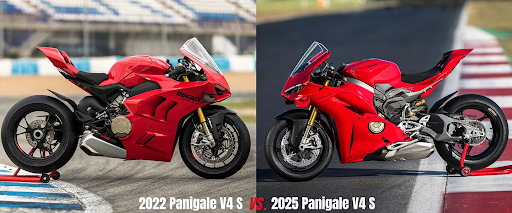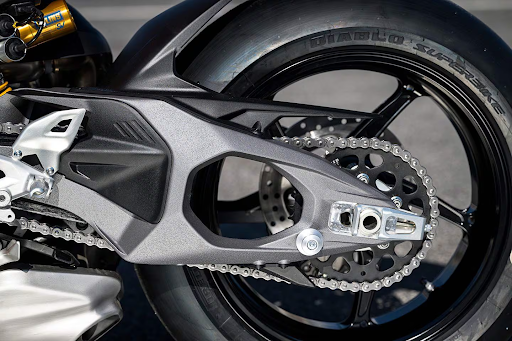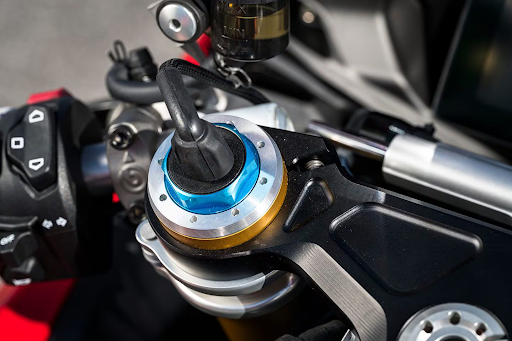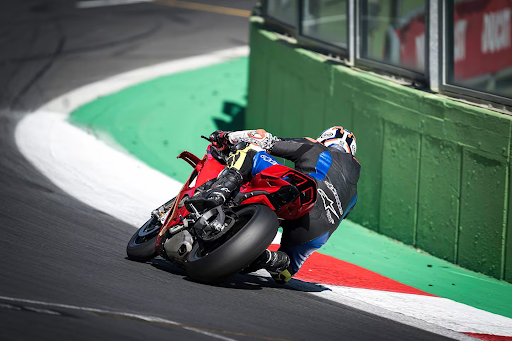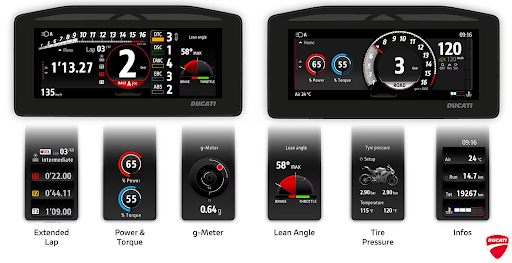Review of the Ducati Panigale V4 S DucatiRide for 2025
The 2025 Panigale V4 is the fourth new or upgraded model to be launched since 2018. Each iteration has made progress toward greater speed stability, but the 2025 version represents a significant leap forward rather than a little step along the same road. Ducati
The 2025 Ducati Panigale V4 is the most forward-thinking mass-production superbike of the current sportbike period, yet I can't help but compare it to previous models while I swoon over the new one. The last Panigale V4 I rode was a 2023 V4 SP2 at Cycle World's superbike shootout. It was gorgeous, swift, and had a clear electronic edge, but with the temperament of an ornery bull that had no intention of letting the rider off easily. The rawness and physical force allowed for a quick lap time, but you couldn't get there without working for it.
Ducati acknowledges that the Panigale's exactness has always been a flaw in its otherwise excellent performance. Engineers smoothed the edges after launching the powerful but too stiff 2018 Panigale V4, first in 2020 and then in 2022. If Ducati's model year revisions demonstrated that less can be more, the 2025 model represents the company's full commitment to the concept that the fastest motorcycles are the simplest to ride. And the 2025 Panigale V4 S is a really fast motorbike.
Identify the differences. Hint: There are many. Interestingly, one of the major design goals for 2025 was to have the double-sided swingarm while still having the exhaust positioned under the engine.
How did we get here?
Ducati's philosophy is derived from racing. Yes, a "friendlier" motorbike will have some advantages on the street and perform well for the casual rider, but the less nerve-racking and physically demanding a motorcycle is, the more a top-level rider can ride at its limits. Performance is wonderful, but so is having some mental capacity and stamina left to concentrate on racecraft.
Peeling back the layers, as we were able to do at a Panigale V4 S riding event that featured extremely open talks with Ducati officials, reveals additional strategic motivations behind Ducati's technological evolutions, particularly the new double-sided swingarm. Why are we here? Why now? Especially after the somewhat regretful return to a single-sided arm on its 2007 1098 superbikes, which followed the competent but rejected 999 with a conventional swingarm that came before it.
The Panigale's redesigned swingarm is known as the Ducati Hollow Symmetrical Swingarm, which apparently allows Ducati to use the term "double-sided" less in discussions about the bike. Large cuts minimize weight both physically and optically. The effort Ducati has made to keep the exhaust beneath the engine is appreciated, as the muffler does not cover the new arm.
According to people familiar with the initiative, Ducati Corse aims to use insights acquired from MotoGP chassis development. What's the point of learning something there if you can't apply it to the World Superbike effort? Especially when, in both situations, the tires and suspension are demanding more from the chassis than ever before—and at deeper lean degrees.
Given World Superbike's homologation-based regulations package, the only option to establish crossover between MotoGP prototype and production-based racing was to convert the Panigale to a double-sided swingarm. Racing influences Ducati's actions, as it has with almost every upgrade to the 2025 Panigale V4. Ducati is first and foremost a performance firm, with emotional, style-driven companies following behind.
Designers were entrusted with paying respect to the classic 916, and they have completely succeeded. When you see this motorbike in person, you will notice the extraordinary attention to detail. Everything is obviously constructed with one goal in mind: a faster lap time. Ducati
Panigale V4S Chassis
The choice to challenge the norm was not taken lightly. It began when management assigned Ducati Corse the responsibility of producing a double-sided swingarm utilizing mass-production means (a cast design with no additional machining) as well as a single-sided swingarm with the same stiffness requirements. Testing of these bikes against a previous-generation Panigale began in early 2021 and was done on three tracks: Vallelunga, Cremona, and Mugello.
"I think that in Ducati's story, we never made such a big development activity," says Carlo Ricci Maccarini, Panigale V4 development team head, when asked what that process was like. "I can tell that the answer did not come [snaps fingers] like that since we identified both positive and bad aspects in every case, but when it came to overall rider satisfaction and lap-time savings, the double-sided won the comparison. "The answer was there."
The 2025 Panigale V4 is the first production bike to feature Brembo's Hypure brake calipers, which are simply outstanding in terms of braking performance and consistency.
The end result is a swingarm with the same longitudinal rigidity (for stability under braking and acceleration), but 37% less lateral rigidity, which provides better feedback, grip, and bump absorption at deeper lean angles, where the suspension is less effective. Ducati claims that the entire "rear-end" weight has been lowered by 5.9 pounds, which includes suspension components, a swingarm, and the forged wheel that comes standard on the higher-spec V4 S, making direct component comparisons to the single-sided layout challenging.
The V4 S differs from the base-model V4 by using an Öhlins NPX 30 fork, Öhlins TTX 36 shock, and Öhlins steering damper, instead of a Showa Big Piston Fork (BPF), Sachs shock, and Sachs steering damper. You also receive forged aluminum wheels instead of cast aluminum hoops, as well as a lithium battery (rather than lead acid). The V4 S's electronic suspension is governed by a third-generation SmartEC 3.0 system that may be set to Fixed or Active mode. The suspension features Öhlins' latest spool valve system (vs. needle valve), which delivers enhanced sensitivity and responsiveness at the low and high end of the adjustment range. It merits its own tale. Paging Mr. Cameron and Mr. Kevin Cameron.
The Öhlins NPX 30 fork replaces the Showa fork on the base-model V4 and allows for a variety of settings between Fixed and Active modes. Given the developments in electronic suspension and excellent performance that completely conceals active modifications, it's difficult to argue for anything other than these systems. Ducati
Perhaps more importantly, the concepts underlying Ducati's new swingarm were carried over to the new front frame, which has 40% less lateral rigidity and weighs 1.6 pounds less. More improvements arrive in the shape of Brembo's new Hypure brake calipers, which are lower weight due to more effective material distribution, have greater heat dissipation, and are supposed to have longer pad life.
Viewed separately, these are all very nice parts, but when you combine them as Ducati has done with the Panigale V4 S, you get something quite special, as evidenced by our day at Vallelunga Circuit, an incredibly unique track that alternates between an eye-watering series of fast corners and hairpins that are extremely tight.
This isn't something you get to do every day. To assist us in quickly getting up to speed and comprehending the new Panigale V4 S, Ducati sent us a data engineer to evaluate the data generated during our six on-track sessions. This was also an opportunity to learn about the capabilities of Ducati's new Ducati Data Logger, which is available as a Ducati Performance accessory. It was developed in partnership with 2D and can capture more than 70 signals related to bike operation and track behavior. The DDL database contains the finish line for over 500 circuits across the world. Once downloaded over Wi-Fi, recorded data may be evaluated using software created by Ducati experts who assisted the bike's on-track development.
Overall, handling is not significantly changed from before. The 2025 V4 S steers comfortably into a turn, but not much faster or with less effort than previous-generation V4s. However, stability and sensation at the contact patch improve, and the bike seems more complete. There is little chassis pitch, and the bike does not bind up when loaded at lean or snap as you speed out of a turn. And, while it may have required some work to stage last year's Panigale protest in this manner, little errors and illogical inputs would serve as a reminder of that bike's edge nature. In racing, even little improvements in calmness and footing make a difference. And for us ordinary mortals, they expand the operating window, allowing us to have more fun at the same (or quicker) speed.
Credit also goes to the combination of outstanding suspension and Brembo brakes, the latter of which provide so much performance that we have no hesitation labeling this the greatest braking package to come standard on a mass-production sportbike. Not only is there a lot of sensation at the lever, but there is so much stopping force that it's difficult to grasp the entire braking capacity. Need to make up time? Simply trust the bike's stability, go deeper, and grip more levers than your mind believes are feasible. The V4 may comment, "Hey, that was kinda fun," without even breaking a sweat.
The chassis feedback is superb, allowing you to confidently drive the Panigale into a bend. This is an incredibly calm, grounded, and confident motorbike. Ducati
Panigale V4S Electronics
Much of the Panigale's performance and control come from its electronics package, which for 2025 includes increasingly advanced systems such as Bosch's Race eCBS combined braking system and Ducati's own Ducati Vehicle Observer (DVO) algorithm, which manages Ducati Traction Control (DTC), Ducati Wheelie Control (DWC), and Ducati Power Launch (DPL). In addition to the DVO-powered technologies, you get "normal" Ducati Slide Control (DSC), Ducati Quick Shift (DQS), and Engine Brake Control (EBC). Five riding modes provide for a wide range of settings, but you can always fine-tune the experience by customizing system options.
Choosing between Race eCBS and DVO is difficult, if only because DVO is extremely complicated and has its roots in Ducati Corse's MotoGP efforts; hence, Ducati does not provide much of a look behind the scenes. Want to see an example of how advanced the system is? Ducati's explanation of the system is simple: "This algorithm estimates physical, kinematic, and dynamic quantities that cannot be measured in practice, which impact the ground forces, accelerations, and maximum torques that the vehicle can bear in various riding conditions."
Much of the buzz around the Panigale V4 is on looks and the double-sided swingarm, but below all that lies one of the most broad (and powerful) electronics systems to ever be mounted to a mass-production sportbike. Ducati
The system "acts like 70 sensors" and analyzes the motorcycle's behavior using IMU data, rather than relying on a large number of physical sensors. To put it another way, the system estimates how much torque can be applied based on the motorcycle's known and predicted dynamics.
What does it do? The best answer we have is that the system does not wait for the rider to make an input before working but rather expects something from the motorcycle based on available data and then begins to move in this direction. Once the rider does what the system expects based on its understanding of the situation, the system gets to work, reducing the time it takes to manage a wheelie or a loss of grip.
Not shown: Ducati Traction Control DVO is working hard to offer us the exact levels of performance we need. Will you ever know exactly how the system works? Probably not, but we promise it works.
Despite the fact that there are seven levels of intervention, Race eCBS is somewhat less perplexing. In ultra-sporty Level 1, the system attempts to replicate what MotoGP riders do, which is to apply some rear brake pressure when the front brake is applied and then continue to apply rear brake pressure at the apex of a corner, even after the front brake has been released. This, according to Ducati, aids in "closing" the corner or maintaining a tighter line.
The following six levels have varying actions, with some delivering connected braking performance but no overrun when the front brake is disengaged and others providing no combined braking function.
The Panigale's electronic systems, including the aforementioned rider aids, are managed by a new and rather sizable 6.9-inch TFT display that is extremely well organized whether in Road or Track display modes. The systems and settings are a lot to digest, and there's an abundance of things to get comfortable manipulating—welcome to the modern, electronics-driven world!
The Race eCBS combined braking system is meant to help the rider keep a tighter line around a turn (particularly in Level 1) and can occasionally be felt working its magic; nonetheless, it does not distract or disrupt the ride. Ducati
We believe that Ducati has been able to reduce the time it takes for the systems to work, which is a significant achievement given how smoothly they operate in the background. This is especially true for things like wheelie control and traction control, which were working during our day at the track, even though we never felt them intervene.
From a big-picture standpoint, we've never tested a more advanced or refined electronics package. These systems aren't just modulating power; they're working alongside you to push you toward a faster lap time and with more composure than you might expect given the absolutely wicked performance of the chassis and engine underneath you.
The 6.9-inch screen can display a variety of statistics, including lean angle, power and torque, and Ducati's "g-meter."
Panigale V4S Engine
Speaking of the engine, we'll admit that we expected the Panigale's 1,103cc 90-degree V-4 to leave the largest impression on us. After all, we're talking about 216 horsepower (209 for US versions), which should be enough to rattle your cage, right?
It is technically true, but in all honesty, the power curve is quite smooth across the rev range. There's no uppercut-like blow at low rpm, nor any peaks or valleys through the midrange—just an incredibly smooth ramping of power that's easy to enjoy as you watch for the dash lights to flash green, indicating it's time to shift. Don't confuse this with slow, though, because even if the engine is smooth, it has a propensity for building speed in a way that few motorcycles can.
The Desmosedici Stradale engine's power delivery isn't overbearing, but it propels you forward in a way that reminds you of its GP heritage. This is a very powerful package.
There's more to the story, of course, because Ducati, like every other manufacturer, is fighting an uphill battle against Euro 5+ emissions regulations, and it's having to make concessions where it might not have wanted to. On the 2025 Panigale V4, this led to exhaust changes—changes that were later offset by adjusting valve timing (more lift) and by widening the sweep of the variable-length intake funnels, which drop another 10 mm in the short configuration and.
Ducati almost absurdly claims a 0.5 hp gain in peak output and slightly less peak torque (89.5 lb.-ft.), while also claiming higher torque at lower rpms. None of these modifications have a meaningful impact on raw power figures.
Electronics do a wonderful job of always ensuring that the Panigale is going ahead. Ducati
In other news, the alternator rotor and oil pump are from the Panigale V4 R, while the gearbox drum is from the Superleggera V4. More importantly for the typical rider, the engine is stated to weigh 2.2 pounds lighter.
There are still different power modes; while we prefer the high power setting that's considered the "standard" power map, you can opt to use a less electronically regulated full setting. There is no difference in peak power, nor is the power character significantly different in Full. However, there's a little more excitement to the whole experience, and for some reason, the engine sounds just a bit angrier. Remember that anger was never Ducati's main goal, so maybe
The Panigale's five ride modes can be easily switched between using the dedicated Mode button and a confirmation button on the switch below. Despite the fact that the electronics package is overwhelmingly involved, the rider can adjust settings with relative ease thanks to the clean layout of the dash and switchgear.
Panigale V4 S: Design and Features
Funny enough, I remember switching to full power mode while riding the previously mentioned 2023 V4 SP2 and how everything began to blur toward the back end of a long straightaway because the bike was beginning to bend time and space, and I couldn't fully escape the wind that I was throwing myself into.
That seems to happen a lot less on the 2025 Panigale, which I have to think is because of the substantial work Ducati continues to undertake in terms of design and aerodynamic improvements. This isn't simply a bike that's been restyled to stand out, but for true performance gain.
This is the first Panigale that we'd define as comfortable and accommodating for taller riders, thanks to its larger and broader seat. Accessory pads will be available and connected to the tail, limiting the seat space for shorter riders.
Ducati claims to have reduced drag by 4% and used a higher windshield to keep the rider in more of a bubble. Smaller changes include repositioned footpegs, which are moved 10mm inward on both sides to keep the rider's legs as far out of the airflow as possible. This also increases cornering clearance.
Ducati claims that moving the leading edge of the fairing back in relation to the front wheel "makes the bike nimbler when changing direction at high speeds." You'd probably need to be Pecco Bagnaia to feel that, but it's hard not to notice the new shape and MotoGP-esque contours, not to mention the redesigned winglets that are integrated into the fairing and feel much less like a tacked-on afterthought. Look closely and you'll notice a handful of other
Both footpegs are moved 10mm inward, keeping the rider's lower leg out of the wind (every little bit helps when it comes to aerodynamics). Other benefits include increased cornering clearance at extreme lean angles and the ability to increase weighted input closer to the center of the bike, which would aid in steering.
The seat area is 1.4 inches longer and 2 inches wider, allowing the rider to move around with greater ease and place their weight where it's needed, as opposed to being locked in place. A flat seat and reshaped tank also help with rideability, especially under braking, so you're not thrown over the front.
Ducati Corse has had a significant impact on everything from the swingarm to different plastic panels, such as these splitters that guide air into the radiators.
Final Thoughts
Admittedly, saying that seems a bit strange. "Oh, how dare the superbike ask great things of the rider?!" Shouldn't we be physically ready for the task at hand?
The answer is, yes, we very much should, because a 200-plus horsepower literbike with aerodynamics and top-level brakes is always going to be a physically and mentally demanding thing. But it doesn't have to be ruthless in its delivery, and in many ways, that's what previous-generation Panigale V4s were: potent but easily pissed off and quick to remind you of who was in charge.
Turning off Ducati Wheelie Control (or any of the rider aids for that matter) reminds you of the brutal force that they're always fighting to protect you from. Ducati
The 2025 V4 turns a corner by effectively underlining that smooth and fast don't have to be mutually incompatible. In fact, the smoother you can create a 200-plus horsepower superbike, the simpler it will be for the rider to continuously squeeze the most out of it.
The Panigale is a motorcycle that works with you, not against you, which makes the experience all the more enjoyable. The bike's performance and forces on your body are still quite extreme, and you'll need to be in good riding shape to ride it for any length of time.
The 4.5-gallon fuel tank has a redesigned form that gives greater support for the rider. A significant concern on the previous-gen Panigales was finding anything to grasp onto under hard braking, and Ducati has now realized that aim with this redesign.


